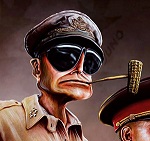|
In training manuals from say the medieval to the early modern age, do they ever cover how to handle psychological issues in officers or men, notably the fact their new profession now involves killing other human beings for a living? Like, do they ever suggest any methods to overcome the instinctive desire not to kill people, or how to manage someone who's getting hosed up on battlefield stress? If it isn't included in manuals, do we have any idea if dealing with those kinds of problems was simply taught as part of the culture, or if it wasn't really addressed at all except on a more or less purely personal level?Trin Tragula posted:100 Years Ago These are pretty excellent. Question: Did the Germans ever realize that such punctual bombardments might be reducing their effectiveness?
|
|
|
|

|
| # ? May 28, 2024 16:04 |
|
CoolCab posted:Getting an enemy commander called von Kluck is exactly the kind of morale coup that allowed the British Empire to thrive. Loving these writeups. Please don't stop. https://www.youtube.com/watch?v=MetBQSkDUoA
|
|
|
|
FAUXTON posted:A big problem (which raised its head in amazing form at Midway) had to do with training. (Shattered Sword is one hell of a read, go check it out now now now) Japanese ship crews weren't set up to handle damage control in the way US crews were. You had a specialized team of DC officers and if they all, say, pass out fighting a fuel fire on the hangar deck or die in an explosion, your damage control ability suddenly drops off a cliff. There was a lot of luck happening at Midway in the USN's favor, but had Japanese crews been trained to a man in some degree of firefighting and shipboard damage control they wouldn't have taken the cataclysmic losses they did at Midway. It would have been disastrous for the IJN while maybe more significant in losses for the USN. You can get lucky with bombs but you never get lucky with a fire on a ship. For perspective, the Yorktown was hit with a bomb hit at the battle of Coral Sea and was reported as sunk by the IJN. After three days of repair she returned to fight at Midway. At midway she was hit by three bombs and reported as destroyed by IJN pilots. After damage control put out the fires she was hit by two torpedoes and reported sunk by IJN pilots. Damage control did what they could but she was abandoned. In the morning the carrier was still afloat and a crew went over to repair her. Yorktown was then hit by a torpedo from a Japanese submarine and THAT finally sunk her. The Japanese flagship, the Akagi was hit by one bomb during the battle. She became a burning wreck and had to be scuttled.
|
|
|
Darth Brooks posted:The Japanese flagship, the Akagi was hit by one bomb during the battle. She became a burning wreck and had to be scuttled. To be fair, though, that one bomb landed in the middle of a flight deck full of refueling and re-arming planes. Lots of poo poo that went boom, in other words. The Yorktown had clear decks when she was hit. Yes, American damage control was much better than the Japanese, but as they say, timing is everything.
|
|
|
|
|
Darth Brooks posted:For perspective, the Yorktown was hit with a bomb hit at the battle of Coral Sea and was reported as sunk by the IJN. After three days of repair she returned to fight at Midway. At midway she was hit by three bombs and reported as destroyed by IJN pilots. After damage control put out the fires she was hit by two torpedoes and reported sunk by IJN pilots. Damage control did what they could but she was abandoned. In the morning the carrier was still afloat and a crew went over to repair her. Yorktown was then hit by a torpedo from a Japanese submarine and THAT finally sunk her. Side question: Did the Commonwealth/German/Italian navies have the same level of damage control as the USN did?
|
|
|
|
jng2058 posted:To be fair, though, that one bomb landed in the middle of a flight deck full of refueling and re-arming planes. Lots of poo poo that went boom, in other words. The Yorktown had clear decks when she was hit. Yes, American damage control was much better than the Japanese, but as they say, timing is everything. Read Shattered Sword, Akagi's decks were clear. She was recycling CAP, not spotting a strike. The bomb penetrated into the hanger and exploded there.
|
|
|
|
Honestly when I think about things like the Akagi and Franklin I start to think the US had an advantage in their greater weight of dive bombers even if their torpedo bombers weren't that great. There isn't really an example of a single torpedo just totally ruining everything like a bomb did on the Franklin on a ship that wasn't fatally flawed and/or a victim of truly terrible practice.
|
|
|
|
xthetenth posted:Honestly when I think about things like the Akagi and Franklin I start to think the US had an advantage in their greater weight of dive bombers even if their torpedo bombers weren't that great. There isn't really an example of a single torpedo just totally ruining everything like a bomb did on the Franklin on a ship that wasn't fatally flawed and/or a victim of truly terrible practice. Juneau - had her poo poo wrecked pretty hard by a single torp to the point where she had to withdraw from battle, where she was later finished off by a submarine. Indianapolis - OK, it was two torpedoes, but both were from the same spread and it was a single strike. Lusitania - I don't know what you mean by "terrible practice" but she went down from one torp Pathfinder - first british warship sunk in WW1, single torp fired by a submarine caused an explosion that blew her in half Start search around and there are plenty. Torpedoes are pretty devastating things, especially if they blow a keel in half rather than detonate on an armored belt.
|
|
|
|
Jaguars! posted:Side question: Did the Commonwealth/German/Italian navies have the same level of damage control as the USN did? The RN/RAN/RNZN/RCN generally did a pretty good job at d/c work. Here's a great collection of the Royal Navy's wartime propaganda/instructional materials on damage control (https://www.navy.gov.au/media-room/publications/wwii-damage-control) xthetenth posted:Honestly when I think about things like the Akagi and Franklin I start to think the US had an advantage in their greater weight of dive bombers even if their torpedo bombers weren't that great. There isn't really an example of a single torpedo just totally ruining everything like a bomb did on the Franklin on a ship that wasn't fatally flawed and/or a victim of truly terrible practice. If you look at the majority of major warship losses during WWII, torpedoes were the primary cause of the sinking or a major contributing factor. It was very hard to sink a capital ship with aerial bombs (smaller ships like destroyers were a different story). Unless they penetrate a magazine, start major fires, or knock out propulsion, aerial bombs generally didn't do enough damage to sink a large warship. To sink a large warship, you needed let water in. Bombs usually hit well above the waterline. Furthermore, heavy cruisers and battleships have topside armor to counter plunging fire (and bombs). Unless you have a really big bomb (like the 12,000lb "Tall Boys" used against Tirpitz) or a really specialized one (like the Type 99 AP bombs used at Pearl Harbor) that armor is drat hard to defeat. Torpedoes, on the other hand, do damage below the waterline. And that kind of damage is generally more dangerous than damage above the waterline. These hits can damage steering (Bismarck), knock out propellers, cause catastrophic lists, start magazine explosions (Barham), knock out key machinery (Courageous), and start uncontrollable flooding. And even if the tin fish didn't sink a ship, torpedo damage was harder and more time-consuming to repair. A torpedoed ship would usually be out of the war longer than a bombed one. You had to put the ship in drydock, patch hokes, repair flooding damage, etc. USS Saratoga got hit by one torpedo (1,080 lb warhead) in January 1942 and wasn't back in action until June 1942. By contrast, USS Yorktown was battle-ready within days of being hit by a 550lb bomb at Coral Sea. Obviously, those are somewhat extreme examples, but they illustrate my point. Torpedo damage was generally more destructive than bomb damage. Now in fairness, flattops (with the exception of British carriers with armored flight decks) were more vulnerable to dive bombing than say, a battleship. A bomb could punch right through an unarmored flight deck and explode in the hangar deck, leading to fuel fires and ordnance explosions. There's multiple examples of this happening in WWII (Akagi at Midway, Franklin, etc.).
|
|
|
|
Ship and sub-launched torpedoes are a very different beast from aerial torpedoes though, aren't they? I think I remember reading ones that while the hit rate of the ship-launched torpedoes by the Japanese were bad, the aerial ones were absolutely terrible. Of course for the US side the early torpedoes were extra terrible.
|
|
|
|
Taerkar posted:Ship and sub-launched torpedoes are a very different beast from aerial torpedoes though, aren't they? I think I remember reading ones that while the hit rate of the ship-launched torpedoes by the Japanese were bad, the aerial ones were absolutely terrible. Of course for the US side the early torpedoes were extra terrible. On paper, air-launched torpedoes weren't as capable. Aerial torpedoes typically carried smaller warheads (usually 50-75% the size of a surface/sub torpedo), and ran shorter and slower than their larger counterparts. But they certainly packed a punch which could kill a small warship and cripple a large one. Air-dropped torpedo accuracy wasn't a design flaw with the torpedoes themselves. Its just very hard to hit a moving target from a moving airplane while you're being shot at. Whereas sub and surface ships had TDCs, time to plot firing solutions, stable launch platforms, and even assistance from radar.
|
|
|
|
So with the wide variety of anti-ship ordnance options available to today's navies, how vulnerable are large aircraft carriers? I know modern anti-missile systems really sophisticated, but there's still only so much damage control can do against fires in a big floating collection of bombs, rockets and kerosene. Can modern aircraft carriers sustain about as much damage as their WW2 counterparts?
|
|
|
|
Cyrano4747 posted:Juneau - had her poo poo wrecked pretty hard by a single torp to the point where she had to withdraw from battle, where she was later finished off by a submarine. I meant against carriers with a particular eye towards Japanese carriers early in the war, sorry. Lighter stuff would totally get wrecked, but as far as turning a capital ship into a raging inferno that doesn't come back a year or so later goes, bombs seem to be more useful. I'm still thinking of the decisive battle scenario. Bacarruda posted:Now in fairness, flattops (with the exception of British carriers with armored flight decks) were more vulnerable to dive bombing than say, a battleship. A bomb could punch right through an unarmored flight deck and explode in the hangar deck, leading to fuel fires and ordnance explosions. There's multiple examples of this happening in WWII (Akagi at Midway, Franklin, etc.). How much protection did the armored decks actually give? I seem to remember them being potentially vulnerable to larger AP bombs and ships taking hits that went through similar thickness hangar deck armor on other nations' carriers.
|
|
|
|
AceRimmer posted:So with the wide variety of anti-ship ordnance options available to today's navies, how vulnerable are large aircraft carriers? Well that entirely depends on how you view the war nerd.  quote:I know modern anti-missile systems really sophisticated, but there's still only so much damage control can do against fires in a big floating collection of bombs, rockets and kerosene. Can modern aircraft carriers sustain about as much damage as their WW2 counterparts? I dunno if we've ever scrapped a nuclear carrier via blowing it up (after the reactor is decommissioned of course) but we shoot up old ships fairly often. Search for SINKEX on youtube to find videos of various weapons tests, in general modern torpedoes are going to break the back of a ship and nothing is going to fix that while missiles will punch a decent hole in the side of the ship which may or may not be survivable.
|
|
|
|
jng2058 posted:To be fair, though, that one bomb landed in the middle of a flight deck full of refueling and re-arming planes. Lots of poo poo that went boom, in other words. The Yorktown had clear decks when she was hit. Yes, American damage control was much better than the Japanese, but as they say, timing is everything. IJN carriers didn't armor their flight decks, so bombs would just fall right through and into whatever was beneath the impact - In the case of the Akagi, one of the hangar decks full of combat-loaded aircraft. This was compounded by the hangar deck being enclosed (instead of open to the outside like USN carriers) and used for refueling/reaming operations. Because of relatively inefficient procedure on every step of the fuel-arm-spot cycle, the hangar deck was loaded with loose poo poo that went boom, and instead of the blast being directed out the sides of an open hangar, it blew up real good almost square in the middle of the boat. Dick Best's 1000 lb bomb hosed up the fire containment screens, likely also the COČ suppression system, and wrecked the amidships elevator. Essentially, it broke the containment capability, remote suppression capability, and made it drat hard to get to the fire to put it out. If anyone in a good firefighting location survived the initial blast from the bomb, it was a crap shoot whether they had damage control training, so instead of everyone down the line knowing how to put out a fire it was a coin toss at absolute best. e: on further reading, the DC issue is made even more prominent by reports from witnesses who state the Akagi didn't go up in flames like the other two ships (Kaga, Soryu) that got hit around the same time. On the other hand, Kaga and Soryu were irretrievably hosed from the get-go. We're talking a thousand-pounder in each of the Soryu's hangar bays, hangar decks on the Kaga just strewn about with 80klbs of ammo and tens of thousands of gallons fuel because of combat operations becoming a massive powder keg waiting to be lit off, bombs landing in ammo storage areas full of 800lb bombs next to the ordnance lift, etc. FAUXTON fucked around with this message at 06:14 on Sep 17, 2014 |
|
|
|
Bacarruda posted:Throughout the entire pre-war period FDR made a clear effort to avoid making public statements that could be taken as pro-war. But he wasn't a raging pacifist in private or in public. By the time that speech was made, it already had been.
|
|
|
|
Tomn posted:These are pretty excellent. Question: Did the Germans ever realize that such punctual bombardments might be reducing their effectiveness? This early in the war it's something that will occasionally identified and attempts will be made to shake things up, which is kind of hard because generally it's easier to do a set routine than consciously keep everything varied all the time. Later the regularity of bombardments will often become a bit of an unspoken agreement between the opposing artillery units which want to stay safe. By only shooting at certain times each side lets the other live another day. This, like all things involving WW1, was very mutable depending on the time, place and people in question.
|
|
|
|
Raenir Salazar posted:Part 2 of the seminal tragedy of the twentieth century. Brought to you by Extra History! Bacarruda posted:Somebody already made a Hitler sitcom (a Hitcom?). It was as big a trainwreck as you'd expect.
|
|
|
|
Bacarruda posted:Air-dropped torpedo accuracy wasn't a design flaw with the torpedoes themselves. Its just very hard to hit a moving target from a moving airplane while you're being shot at. Whereas sub and surface ships had TDCs, time to plot firing solutions, stable launch platforms, and even assistance from radar. What is TDC?
|
|
|
|
Arquinsiel posted:There's a lot of imagining what was going through the heads of people who died before being able to tell anyone, but it really works.
|
|
|
|
Frostwerks posted:What is TDC?
|
|
|
|
Bacarruda posted:The RN/RAN/RNZN/RCN generally did a pretty good job at d/c work. That's an awesome source, thanks for linking it! There are some quite early war examples there as well, I imagine that as the war went on, allied navies would have got better from sharing techniques between the various navies. Jaguars! fucked around with this message at 11:05 on Sep 17, 2014 |
|
|
|
The Japanese alternative plan to Midway was indeed to capture islands between the US and Australia, making sailing between the two very difficult, though not impossible. Personally, I think if Midway had been a big win, they'd have more seriously considered attacking Hawaii. In any case, Japan was pressing the limit of what their men and transport could cover. Never forget about the fighting in China, which absorbed massive resources all the way to 1945. Sealion, apparently, was never a real plan. Hitler and the other big shots were already focused on Russia. They seemed to think a stalemate with the British was acceptable.
|
|
|
|
Azathoth posted:I read somewhere that at the end of 1945, the U.S. had 50% of the world's GDP. Think about that for a moment. This is because the rest of the worlds factories were bombed out and the worlkforces were in disarray, or in the case of Russia, not particularly interested in capitalistic pursuits. As a side rant this was always a gripe I had with my grandfathers generation whenever he'd whine about how my generation was letting it all slip away. The only way that state of affairs would have stayed in place is if Germany/France/most of Europe really remained a bombed out hellscape.
|
|
|
|
BurningStone posted:The Japanese alternative plan to Midway was indeed to capture islands between the US and Australia, making sailing between the two very difficult, though not impossible. Personally, I think if Midway had been a big win, they'd have more seriously considered attacking Hawaii. In any case, Japan was pressing the limit of what their men and transport could cover. Never forget about the fighting in China, which absorbed massive resources all the way to 1945. There was also the fact that the Imperial Army completely refused to take part in any of these plans.
|
|
|
|
Kemper Boyd posted:There was also the fact that the Imperial Army completely refused to take part in any of these plans. Inter-service rivalry between the IJA and IJN was amazing. I'm not sure any country had a worse inter-service rivalry (not counting civil wars).
|
|
|
|
Cyrano4747 posted:
To be fair, this one is an ocean liner not a warship. One advantage British carriers did have in the East was that they had armoured decks, which is quite handy for resilience against bombs and kamikazes (with the tradeoff that there's less space for planes, of course).
|
|
|
|
wdarkk posted:Inter-service rivalry between the IJA and IJN was amazing. I'm not sure any country had a worse inter-service rivalry (not counting civil wars). Any particular sources on this you'd recommend?
|
|
|
|
Grand Prize Winner posted:Any particular sources on this you'd recommend? Not offhand. I remember it being discussed many times in works on some other aspect of the Pacific war. Shattered Sword, for example, quotes Tojo being smug about goddamn Midway because he's part of the army faction.
|
|
|
|
Yeah, Shattered Sword talks about how after their initial conquest spree, the Japanese are trying to decide where to next - cut off Australia? Midway? The Aleutians? Invade Australia directly? Since the Army only grudgingly gave up troops for the project to conquer the Philippines, Malayasia, Indonesia, etc in the first place, after conquering all of that they basically vetoed any further offensives that would require them to commit troops because this whole Pacific War thing is the Navy's baby, so if the Navy wants to conquer some Pacific real estate for more naval bases they need to provide their own landing troops. Oh, yeah, and the Navy did indeed have its own ground troops. And both services operated a land-based air arm with their own models of bombers and fighters. I'm pretty sure the Army operated its own transport ships too.
|
|
|
|
Pornographic Memory posted:Oh, yeah, and the Navy did indeed have its own ground troops. And both services operated a land-based air arm with their own models of bombers and fighters. I'm pretty sure the Army operated its own transport ships too. Hell, the IJA had their own submarines. Perhaps best known for being mistaken for the enemy and rammed by an allied freighter.
|
|
|
|
Kemper Boyd posted:There was also the fact that the Imperial Army completely refused to take part in any of these plans. Hell, even within the IJN there was rancor over air/sea power doctrine and whether you were with the whiz kids who saw flattops as the future (Yamamoto) or with the old guard who probably saw the same thing but built their career under battleships being the paradigm and thus considered it a matter of pride (basically everyone else at the imperial general HQ back in Tokyo) to make a showing with heavy armor and big guns. Add to this Yamamoto's brashness in operations against the realpolitik concerns of people like Adm. Nagano (Yamamoto's superior) regarding drawing the US into a war so quickly. Basically, the IJN alone had enough command dysfunction to doom the war effort before you even consider the possibility of how the hell tiny-rear end Japan was supposed to support holdings practically halfway across the planet in wartime after going to war with their biggest source of raw materials.
|
|
|
|
Bro Enlai posted:Hell, the IJA had their own submarines. Perhaps best known for being mistaken for the enemy and rammed by an allied freighter. And they had carriers too (sorta): http://en.wikipedia.org/wiki/Imperial_Japanese_Army_Air_Service#Army_Escort-Aircraft_Carriers
|
|
|
|
Bro Enlai posted:Hell, the IJA had their own submarines. Perhaps best known for being mistaken for the enemy and rammed by an allied freighter. Considering the interservice relations, "mistaken" should perhaps be changed to "correctly identified as".
|
|
|
|
Really the thing that never ceases to amaze me about WW2 is how the Axis powers managed to achieve so very much with so very little and with such dysfunctional leadership. Apart from the Italians, who could never get anything right.
|
|
|
Alchenar posted:Really the thing that never ceases to amaze me about WW2 is how the Axis powers managed to achieve so very much with so very little and with such dysfunctional leadership. Hey! They successfully conquered the military powerhouse that was Albania
|
|
|
|
|
Alchenar posted:Really the thing that never ceases to amaze me about WW2 is how the Axis powers managed to achieve so very much with so very little and with such dysfunctional leadership. The sad truth is that for the first part of the war the Allies basically out-incompetenced them. Taerkar fucked around with this message at 21:58 on Sep 17, 2014 |
|
|
|
Ferrosol posted:Hey! They successfully conquered the military powerhouse that was Albania And Ethiopia! after cheating with poison gas
|
|
|
|
Grand Prize Winner posted:Any particular sources on this you'd recommend? Kaigun's got a decent bit of it in discussion of their manpower woes. It turns out that the IJA ran conscription, so the IJN had a hard time getting enough decent conscripts. There was even a problem with important civilian employees of the IJN getting drafted by the IJA.
|
|
|
|

|
| # ? May 28, 2024 16:04 |
|
What was the state of naval warfare during the crusader era? In my mind I picture the galleys and triremes and such from ancient times, and then a massive blank for a dozen centuries, and then suddenly it's the age of sail. What did the ships look like? What was combat like? Did anyone on the receiving end of a crusade ever try to oppose them at sea (if this was even possible)?
|
|
|
|





























 Dan does a good job capturing the emotion of it all.
Dan does a good job capturing the emotion of it all.










